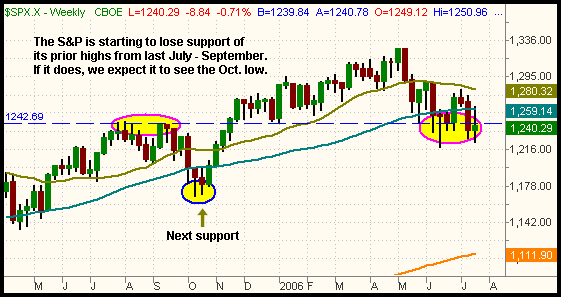Disappointing earnings outlooks from tech giants Dell Inc. and Broadcom Corp. triggered a 4.8% slide in the Semiconductor Index ($SOX) last Friday, causing the broad market to suffer another day of losses on higher volume. The Nasdaq Composite dropped 0.9%, the S&P 500 lost 0.7%, and the Dow Jones Industrial Average closed 0.5% lower. As we have become accustomed to seeing on weak days, small and mid-cap stocks again led the broad market to the downside. The Russell 2000 slid 1.7% and the S&P Midcap 400 fell 1.5%. All of the losses occurred in the first hour trading, as the major indices traded in a narrow, sideways range throughout the remainder of the session. For the week, the S&P 500 gained 0.3%, but the Nasdaq lost 0.8%. After Wednesday's sharp rally, all the major indices were poised for substantial weekly gains, but those gains evaporated in the following two days.
Total volume in the NYSE rose by 14%, while volume in the Nasdaq was 13% higher than the previous day's level. Part of the rise in turnover was attributed to monthly options expiration day, but the broad-based losses on higher volume still resulted in both the S&P and Nasdaq having another bearish "distribution day" that indicated institutional selling. Last Thursday's losses on lighter volume was encouraging to the bulls, but Friday's higher volume losses tell us that mutual funds, hedge funds, and other institutions are still in selling mode. Until we begin to see a pattern of declining volume on the down days and higher volume on the up days, we must assume the market remains unhealthy "under the hood."
We generally focus on the daily charts of the major indices, as chart patterns on that time frame are where most of our ETF trades are focused. However, the longer-term weekly charts are important for showing the "big picture" of what is really happening in the broad market. Since we usually study the long-term charts at least once a week, let's take an updated look at the weekly charts of the major indices. Doing so will enable us to have a clear picture of the intermediate to long-term trends. First, we'll assess the weekly chart of the Nasdaq Composite:

As you can see, the Nasdaq had its lowest weekly closing price since the week ending May 13, 2005. More importantly, it closed right at the intra-week low of the week ending October 14, 2005. This is represented by the dashed horizontal line at the 2,025 price level. Keep a close eye on this price level going into this week, as it is a very pivotal area of support. A solid break below that intra-week low from last October would represent the first major "lower low" since August of 2004. A subsequent "lower high" would represent the formation of a new primary downtrend. If the 2,025 level is firmly broken, the next major support is the low of April 2005, around the 1,900 area. Conversely, if the October low holds as support, expect the Nasdaq to find major overhead resistance at the 2,190 level, which is the prior high of the current downtrend. Next, let's analyze the weekly chart of the S&P 500:

After only a quick glance at the S&P chart, one immediately notices how much better the S&P has been holding up than the Nasdaq. Unlike the Nasdaq, which closed last week right at its intra-week low of October 2005, the S&P is still well above its October low. The dashed horizontal line on the S&P chart represents support of the prior highs from July through September 2005. The S&P has been trying to hold above that level for the past seven weeks, but it closed just below it last week. If the intra-week low from last month is broken, the October low around 1,170 would become the downside target.
Comparing the charts of the S&P and Nasdaq, it quickly becomes apparent that the Nasdaq has been showing a lot more relative weakness ever since the selloff began. This, however, is typical because the Nasdaq generally leads the S&P when in an uptrending market as well. The technology related sectors are the weakest of all, but we expect the S&P and Dow to start playing "catch up" to the relative weakness in the Nasdaq. Many sectors in the S&P have more downside potential, and therefore a better risk/reward ratio, than the tech sectors such as the Semis. We mentioned Transportation (IYT) in last Thursday's newsletter and we still feel that will be one of the next formerly market-leading sectors to crack. We'll be stalking IYT for a potential short sale entry over the coming week. Conversely, the only thing we would touch on the long side right now are some of the fixed-income ETFs such as the iShares Corporate Bond Fund (LQD), which we bought on July 20.
Deron Wagner is the Founder and Head Trader of both Morpheus Capital LP, a U.S. hedge fund, and Morpheus Trading Group, a trader education firm launched in 2001 that provides daily technical analysis of the leading ETFs and stocks. For a free trial to the full version of The Wagner Daily or to learn about Wagner's other services, visit MorpheusTrading.com or send an e-mail to deron@morpheustrading.com.